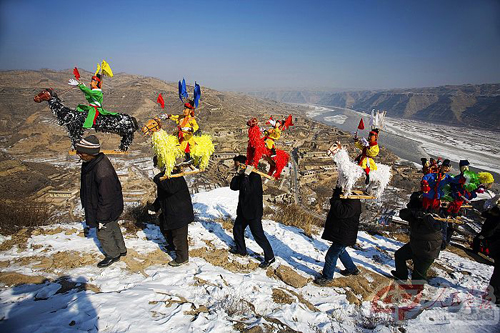Mid-Way through the Great Wall
Yulin visitors can also enjoy folk customs with strong Shaanxi flavor. In Jiaxian County, on the west bank of the Jinshan Gorge in the middle reaches of the Yellow River in northeast Shaanxi Province, lucky tourists can enjoy the annual local "amnesty ceremony" as well as "circling nine bends," a folk performance held only once every six years.
The "amnesty ceremony" is unique to Jiaxian area, and no one is sure exactly when it originated. Legend goes that in distant antiquity, Jiaxian people suffered from plagues, floods and devil monsters, before Zhang Daoling (34-156), the founder of Taoism, along with the Eight Immortals, constructed an altar to dispel devils. The service lasted 49 days, and eventually they harnessed a devil black dragon and dispelled the plagues, bringing eternal peace to locals. Later, in memory of their saviors, locals began to hold the "amnesty ceremony" on the ninth day of the first lunar month each year, hoping it would help drive out all sins and disasters. It is also a way in which locals pray for peace and good harvests. With the passage of time, the ceremony has become a folk performance more than a religious rite.
Typically, the "amnesty ceremony" takes place atop a cliff nearby the village, where four horse-riding wooden celestial warriors that represent the year, month, day and time are strung along a 1,000-meter-long rope with the Eight Immortals of Taoism and the God of Longevity riding a celestial crane. All of the immortals and horses are wooden miniatures exquisitely carved according to their real scales. Locals repair and restore the wooden figures each year — peeling off cracked paint, then coating them with red putty and applying grounding, finally repainting them with mineral pigments and color lacquers.
|
|
|
On the ninth day of each first lunar month, local villagers carry wood-carved immortals riding horses atop the cliff and slip them down along a rope, an important activity during the "amnesty ceremony."[Photo by Huang Dong] |
"Circling nine bends" is a folk activity involving praying for good harvest and health, which takes place on the Lantern Festival (the 15th day of the first lunar month) once every six years. Typically, the activity is staged in a spacious, flat lot. Locals use 361 sorghum stalks to form a square array consisting of nine zones with nine bends. On the sorghum stalks 360 oil lamps, donated by local households, are placed. A yellow flag is hung on a pole in the center, beneath which is a drawing of the Eight Diagrams. The entire array resembles a sketch map of a city linked by a nine-bend trail, while its nine zones appear like smaller cities with various openings.
Usually, "circling nine bends" takes place at dusk. "Light up the lamps," shouts an emcee, heralding the beginning of the performance. The 360 oil lamps are then illuminated one by one, and the night becomes as bright as midday. Locals beat gongs and drums, filling the night air with their excited cries. All villagers, men and women, as well as their relatives and friends from nearby villages, gather together. They walk around the array three times, and then enter the nine bends. Adults even carry sick family members on their back, so they don't miss the festivities. While walking, they sing folk tunes which resonate throughout the space.
Locals believe that after walking through the nine bends, they and their livestock will be safe from illness, they will enjoy a good harvest, and peace will spread throughout the world.
|
|
|
Ruins of the Great Wall.[Photo by Huang Dong] |
Links:
Situated in northernmost Shaanxi Province, the city of Yulin occupies an area of 43,578 square kilometers and has a population of 3.56 million. A famous city with historical and cultural significance, Yulin features plentiful historic relics. Today, the city can be reached through direct flights from Beijing, Shanghai and Xi'an.
 0
0 










Go to Forum >>0 Comments